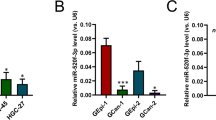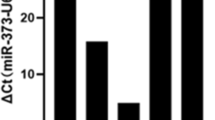Abstract
MicroRNAs (miRNAs) from the gene cluster miR-143–145 are diminished in cells of colorectal tumor origin when compared with normal colon epithelia. Until now, no report has addressed the coordinate action of these miRNAs in colorectal cancer (CRC). In this study, we performed a comprehensive molecular and functional analysis of the miRNA cluster regulatory network. First, we evaluated proliferation, migration, anchorage-independent growth and chemoresistance in the colon tumor cell lines after miR-143 and miR-145 restoration. Then, we assessed the contribution of single genes targeted by miR-143 and miR-145 by reinforcing their expression and checking functional recovery. Restoring miR-143 and miR-145 in colon cancer cells decreases proliferation, migration and chemoresistance. We identified cluster of differentiation 44 (CD44), Kruppel-like factor 5 (KLF5), Kirsten rat sarcoma 2 viral oncogene homolog (KRAS) and v-Raf murine sarcoma viral oncogene homolog B1 (BRAF) as proteins targeted by miR-143 and miR-145. Their re-expression can partially revert a decrease in transformation properties caused by the overexpression of miR-143 and miR-145. In addition, we determined a set of mRNAs that are diminished after reinforcing miR-143 and miR-145 expression. The whole transcriptome analysis ascertained that downregulated transcripts are enriched in predicted target genes in a statistically significant manner. A number of additional genes, whose expression decreases as a direct or indirect consequence of miR-143 and miR-145, reveals a complex regulatory network that affects cell signaling pathways involved in transformation. In conclusion, we identified a coordinated program of gene repression by miR-143 and miR-145, in CRC, where either of the two miRNAs share a target transcript, or where the target transcripts share a common signaling pathway. Major mediators of the oncosuppression by miR-143 and miR-145 are genes belonging to the growth factor receptor–mitogen-activated protein kinase network and to the p53 signaling pathway.
This is a preview of subscription content, access via your institution
Access options
Subscribe to this journal
Receive 50 print issues and online access
$259.00 per year
only $5.18 per issue
Buy this article
- Purchase on Springer Link
- Instant access to full article PDF
Prices may be subject to local taxes which are calculated during checkout





Similar content being viewed by others
Accession codes
References
Cordes KR, Sheehy NT, White MP, Berry EC, Morton SU, Muth AN et al. miR-145 and miR-143 regulate smooth muscle cell fate and plasticity. Nature 2009; 460: 705–710.
Takagi T, Iio A, Nakagawa Y, Naoe T, Tanigawa N, Akao Y . Decreased expression of microRNA-143 and -145 in human gastric cancers. Oncology 2009; 77: 12–21.
Gao W, Yu Y, Cao H, Shen H, Li X, Pan S et al. Deregulated expression of miR-21, miR-143 and miR-181a in non small cell lung cancer is related to clinicopathologic characteristics or patient prognosis. Biomed Pharmacother 2010; 64: 399–408.
Bockmeyer CL, Christgen M, Muller M, Fischer S, Ahrens P, Langer F et al. MicroRNA profiles of healthy basal and luminal mammary epithelial cells are distinct and reflected in different breast cancer subtypes. Breast Cancer Res Treat 2011; 130: 735–745.
Suzuki HI, Yamagata K, Sugimoto K, Iwamoto T, Kato S, Miyazono K . Modulation of microRNA processing by p53. Nature 2009; 460: 529–533.
Sachdeva M, Zhu S, Wu F, Wu H, Walia V, Kumar S et al. p53 represses c-Myc through induction of the tumor suppressor miR-145. Proc Natl Acad Sci USA 2009; 106: 3207–3212.
Kent OA, Chivukula RR, Mullendore M, Wentzel EA, Feldmann G, Lee KH et al. Repression of the miR-143/145 cluster by oncogenic Ras initiates a tumor-promoting feed-forward pathway. Genes Dev 2010; 24: 2754–2759.
Villadsen SB, Bramsen JB, Ostenfeld MS, Wiklund ED, Fristrup N, Gao S et al. The miR-143/-145 cluster regulates plasminogen activator inhibitor-1 in bladder cancer. Br J Cancer 2011; 106: 366–374.
Batliner J, Buehrer E, Fey MF, Tschan MP . Inhibition of the miR-143/145 cluster attenuated neutrophil differentiation of APL cells. Leuk Res 2012; 36: 237–240.
Shi B, Sepp-Lorenzino L, Prisco M, Linsley P, deAngelis T, Baserga R et al. 145 targets the insulin receptor substrate-1 and inhibits the growth of colon cancer cells. J Biol Chem 2007; 282: 32582–32590.
Ng EK, Tsang WP, Ng SS, Jin HC, Yu J, Li JJ et al. MicroRNA-143 targets DNA methyltransferases 3A in colorectal cancer. Br J Cancer 2009; 101: 699–706.
Esau C, Kang X, Peralta E, Hanson E, Marcusson EG, Ravichandran LV et al. MicroRNA-143 regulates adipocyte differentiation. J Biol Chem 2004; 279: 52361–52365.
Nandan MO, McConnell BB, Ghaleb AM, Bialkowska AB, Sheng H, Shao J et al. Kruppel-like factor 5 mediates cellular transformation during oncogenic KRAS-induced intestinal tumorigenesis. Gastroenterology 2008; 134: 120–130.
Godar S, Ince TA, Bell GW, Feldser D, Donaher JL, Bergh J et al. Growth-inhibitory and tumor- suppressive functions of p53 depend on its repression of CD44 expression. Cell 2008; 134: 62–73.
Baron U, Bujard H . Tet repressor-based system for regulated gene expression in eukaryotic cells: principles and advances. Methods Enzymol 2000; 327: 401–421.
Friedman RC, Farh KK, Burge CB, Bartel DP . Most mammalian mRNAs are conserved targets of microRNAs. Genome Res 2009; 19: 92–105.
Chen X, Guo X, Zhang H, Xiang Y, Chen J, Yin Y et al. Role of miR-143 targeting KRAS in colorectal tumorigenesis. Oncogene 2009; 28: 1385–1392.
Hsu JB, Chiu CM, Hsu SD, Huang WY, Chien CH, Lee TY et al. miRTar: an integrated system for identifying miRNA-target interactions in human. BMC Bioinformatics 2011; 12: 300.
Brest P, Lapaquette P, Souidi M, Lebrigand K, Cesaro A, Vouret-Craviari V et al. A synonymous variant in IRGM alters a binding site for miR-196 and causes deregulation of IRGM-dependent xenophagy in Crohn’s disease. Nat Genet 2011; 43: 242–245.
Elcheva I, Goswami S, Noubissi FK, Spiegelman VS . CRD-BP protects the coding region of betaTrCP1 mRNA from miR-183-mediated degradation. Mol Cell 2009; 35: 240–246.
Lewis BP, Shih IH, Jones-Rhoades MW, Bartel DP, Burge CB . Prediction of mammalian microRNA targets. Cell 2003; 115: 787–798.
Nonne N, Ameyar-Zazoua M, Souidi M, Harel-Bellan A . Tandem affinity purification of miRNA target mRNAs (TAP Tar). Nucleic Acids Res 2010; 38: e20.
Guo H, Ingolia NT, Weissman JS, Bartel DP . Mammalian microRNAs predominantly act to decrease target mRNA levels. Nature 2010; 466: 835–840.
Huang da W, Sherman BT, Lempicki RA . Systematic and integrative analysis of large gene lists using DAVID bioinformatics resources. Nat Protoc 2009; 4: 44–57.
Dennis G, Sherman BT, Hosack DA, Yang J, Gao W, Lane HC et al. DAVID: database for annotation, visualization, and integrated discovery. Genome Biol 2003; 4: P3.
Baek D, Villen J, Shin C, Camargo FD, Gygi SP, Bartel DP . The impact of microRNAs on protein output. Nature 2008; 455: 64–71.
Selbach M, Schwanhausser B, Thierfelder N, Fang Z, Khanin R, Rajewsky N . Widespread changes in protein synthesis induced by microRNAs. Nature 2008; 455: 58–63.
Zhu H, Dougherty U, Robinson V, Mustafi R, Pekow J, Kupfer S et al. EGFR signals downregulate tumor suppressors miR-143 and miR-145 in Western diet-promoted murine colo cancer: role of G1 regulators. MOl Cancer Res 2011; 9: 960–975.
Kent OA, Fox-Talbot K, Halushka MK . RREB1 repressed miR-143/145 modulates KRAS signaling through downregulation of multiple targets. Oncogene 2013; 32: 2576–2585..
Bushati N, Cohen SM . microRNA functions. Annu Rev Cell Dev Biol 2007; 23: 175–205.
Kloosterman WP, Plasterk RH . The diverse functions of microRNAs in animal development and disease. Dev Cell 2006; 11: 441–450.
Rubinson DA, Dillon CP, Kwiatkowski AV, Sievers C, Yang L, Kopinja J et al. A lentivirus-based system to functionally silence genes in primary mammalian cells, stem cells and transgenic mice by RNA interference. Nat Genet 2003; 33: 401–406.
Baron U, Gossen M, Bujard H . Tetracycline-controlled transcription in eukaryotes: novel transactivators with graded transactivation potential. Nucleic Acids Res 1997; 25: 2723–2729.
Ricci-Vitiani L, Pedini F, Mollinari C, Condorelli G, Bonci D, Bez A et al. Absence of caspase 8 and high expression of PED protect primitive neural cells from cell death. J Exp Med 2004; 200: 1257–1266.
Ricci-Vitiani L, Mollinari C, di Martino S, Biffoni M, Pilozzi E, Pagliuca A et al. Thymosin beta4 targeting impairs tumorigenic activity of colon cancer stem cells. Faseb J 2010; 24: 4291–4301.
Acknowledgements
This work was supported by grant from Associazione Italiana per la Ricerca sul Cancro, AIRC (Start-up 6326 to LR-V and Regional Fellowship to CV). We thank Tania Merlino for contribution in editing the manuscript.
Author information
Authors and Affiliations
Corresponding author
Ethics declarations
Competing interests
The authors declare no conflict of interest.
Additional information
Supplementary Information accompanies the paper on the Oncogene website
Supplementary information
Rights and permissions
About this article
Cite this article
Pagliuca, A., Valvo, C., Fabrizi, E. et al. Analysis of the combined action of miR-143 and miR-145 on oncogenic pathways in colorectal cancer cells reveals a coordinate program of gene repression. Oncogene 32, 4806–4813 (2013). https://doi.org/10.1038/onc.2012.495
Received:
Revised:
Accepted:
Published:
Issue Date:
DOI: https://doi.org/10.1038/onc.2012.495
Keywords
This article is cited by
-
Expression Profile of Circulating Exosomal microRNAs in Leukoplakia, Oral Submucous Fibrosis, and Combined Lesions of Leukoplakia and Oral Submucous Fibrosis
Head and Neck Pathology (2024)
-
LncRNA UCC promotes epithelial–mesenchymal transition via the miR-143-3p/SOX5 axis in non-small-cell lung cancer
Laboratory Investigation (2021)
-
The mir-767-105 cluster: a crucial factor related to the poor prognosis of hepatocellular carcinoma
Biomarker Research (2020)
-
SPATS2, negatively regulated by miR-145-5p, promotes hepatocellular carcinoma progression through regulating cell cycle
Cell Death & Disease (2020)
-
The rs7911488-T allele promotes the growth and metastasis of colorectal cancer through modulating miR-1307/PRRX1
Cell Death & Disease (2020)



